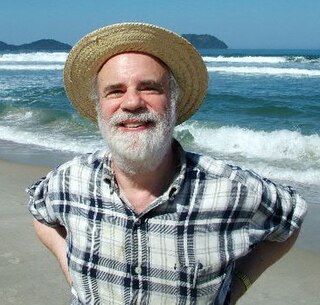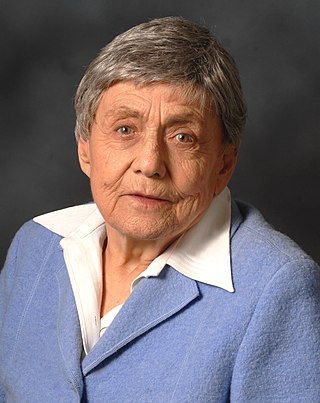Related Research Articles

Willard Van Orman Quine was an American philosopher and logician in the analytic tradition, recognized as "one of the most influential philosophers of the twentieth century". He served as the Edgar Pierce Chair of Philosophy at Harvard from 1956 to 1978.

Saul Aaron Kripke was an American analytic philosopher and logician. He was Distinguished Professor of Philosophy at the Graduate Center of the City University of New York and emeritus professor at Princeton University. Kripke is considered one of the most important philosophers of the latter half of the 20th century. Since the 1960s, he has been a central figure in a number of fields related to mathematical and modal logic, philosophy of language and mathematics, metaphysics, epistemology, and recursion theory.

Ruth Barcan Marcus was an American academic philosopher and logician best known for her work in modal and philosophical logic. She developed the first formal systems of quantified modal logic and in so doing introduced the schema or principle known as the Barcan formula. Marcus, who originally published as Ruth C. Barcan, was, as Don Garrett notes "one of the twentieth century's most important and influential philosopher-logicians". Timothy Williamson, in a 2008 celebration of Marcus' long career, states that many of her "main ideas are not just original, and clever, and beautiful, and fascinating, and influential, and way ahead of their time, but actually – I believe – true".

David Kellogg Lewis was an American philosopher who is widely regarded as one of the most important philosophers of the 20th century. Lewis taught briefly at UCLA and then at Princeton University from 1970 until his death. He is closely associated with Australia, whose philosophical community he visited almost annually for more than 30 years.

A propositional attitude is a mental state held by an agent or organism toward a proposition.
De dicto and de re are two phrases used to mark a distinction in intensional statements, associated with the intensional operators in many such statements. The distinction is used regularly in metaphysics and in philosophy of language.
In modal logic and the philosophy of language, a term is said to be a rigid designator or absolute substantial term when it designates the same thing in all possible worlds in which that thing exists. A designator is persistently rigid if it also designates nothing in all other possible worlds. A designator is obstinately rigid if it designates the same thing in every possible world, period, whether or not that thing exists in that world. Rigid designators are contrasted with connotative terms, non-rigid or flaccid designators, which may designate different things in different possible worlds.
A possible world is a complete and consistent way the world is or could have been. Possible worlds are widely used as a formal device in logic, philosophy, and linguistics in order to provide a semantics for intensional and modal logic. Their metaphysical status has been a subject of controversy in philosophy, with modal realists such as David Lewis arguing that they are literally existing alternate realities, and others such as Robert Stalnaker arguing that they are not.
"Two Dogmas of Empiricism" is a paper by analytic philosopher Willard Van Orman Quine published in 1951. According to University of Sydney professor of philosophy Peter Godfrey-Smith, this "paper [is] sometimes regarded as the most important in all of twentieth-century philosophy". The paper is an attack on two central aspects of the logical positivists' philosophy: the first being the analytic–synthetic distinction between analytic truths and synthetic truths, explained by Quine as truths grounded only in meanings and independent of facts, and truths grounded in facts; the other being reductionism, the theory that each meaningful statement gets its meaning from some logical construction of terms that refer exclusively to immediate experience.
David Benjamin Kaplan is an American philosopher. He is the Hans Reichenbach Professor of Scientific Philosophy at the UCLA Department of Philosophy. His philosophical work focuses on the philosophy of language, logic, metaphysics, epistemology and the philosophy of Frege and Russell. He is best known for his work on demonstratives, propositions, and reference in intensional contexts. He was elected a Fellow of the American Academy of Arts & Sciences in 1983 and a Corresponding Fellow of the British Academy in 2007.
In predicate logic, universal instantiation is a valid rule of inference from a truth about each member of a class of individuals to the truth about a particular individual of that class. It is generally given as a quantification rule for the universal quantifier but it can also be encoded in an axiom schema. It is one of the basic principles used in quantification theory.
Intensional logic is an approach to predicate logic that extends first-order logic, which has quantifiers that range over the individuals of a universe (extensions), by additional quantifiers that range over terms that may have such individuals as their value (intensions). The distinction between intensional and extensional entities is parallel to the distinction between sense and reference.
In any of several fields of study that treat the use of signs — for example, in linguistics, logic, mathematics, semantics, semiotics, and philosophy of language — an extensional context is a syntactic environment in which a sub-sentential expression e can be replaced by an expression with the same extension and without affecting the truth-value of the sentence as a whole. Extensional contexts are contrasted with opaque contexts where truth-preserving substitutions are not possible.
The literal translation of the Latin "salva veritate" is "with unharmed truth", using ablative of manner: "salva" meaning "rescue," "salvation," or "welfare," and "veritate" meaning "reality" or "truth". Thus, Salva veritate is the logical condition by which two expressions may be interchanged without altering the truth-value of statements in which the expressions occur. Substitution salva veritate of co-extensional terms can fail in opaque contexts.
The analytic–synthetic distinction is a semantic distinction used primarily in philosophy to distinguish between propositions that are of two types: analytic propositions and synthetic propositions. Analytic propositions are true or not true solely by virtue of their meaning, whereas synthetic propositions' truth, if any, derives from how their meaning relates to the world.
In philosophy, specifically in the area of metaphysics, counterpart theory is an alternative to standard (Kripkean) possible-worlds semantics for interpreting quantified modal logic. Counterpart theory still presupposes possible worlds, but differs in certain important respects from the Kripkean view. The form of the theory most commonly cited was developed by David Lewis, first in a paper and later in his book On the Plurality of Worlds.
This is an index of Wikipedia articles in philosophy of language
In predicate logic, existential generalization is a valid rule of inference that allows one to move from a specific statement, or one instance, to a quantified generalized statement, or existential proposition. In first-order logic, it is often used as a rule for the existential quantifier in formal proofs.
In modal logic, the necessity of identity is the thesis that for every object x and object y, if x and y are the same object, it is necessary that x and y are the same object. The thesis is best known for its association with Saul Kripke, who published it in 1971, although it was first derived by the logician Ruth Barcan Marcus in 1947, and later, in simplified form, by W. V. O. Quine in 1953.